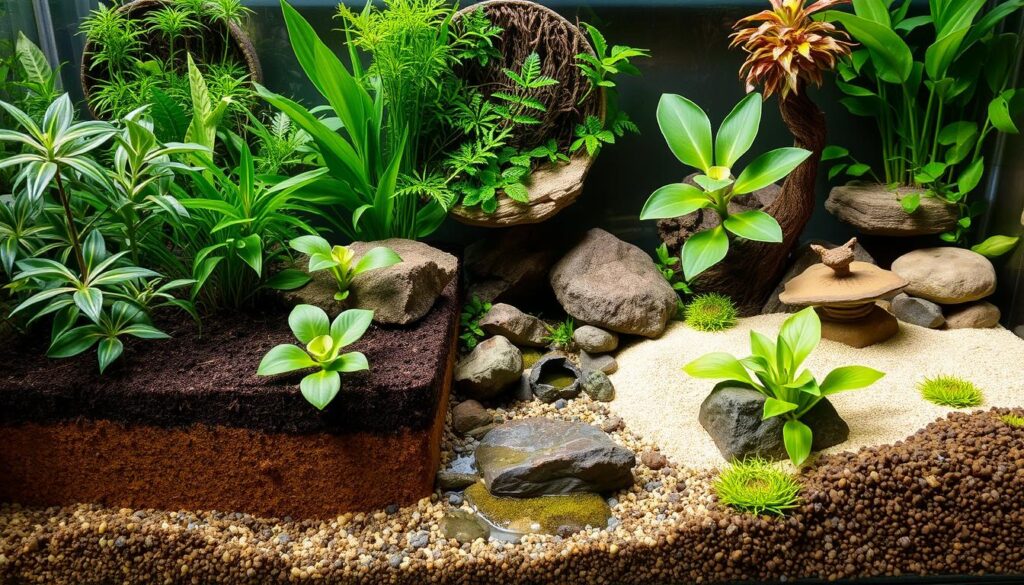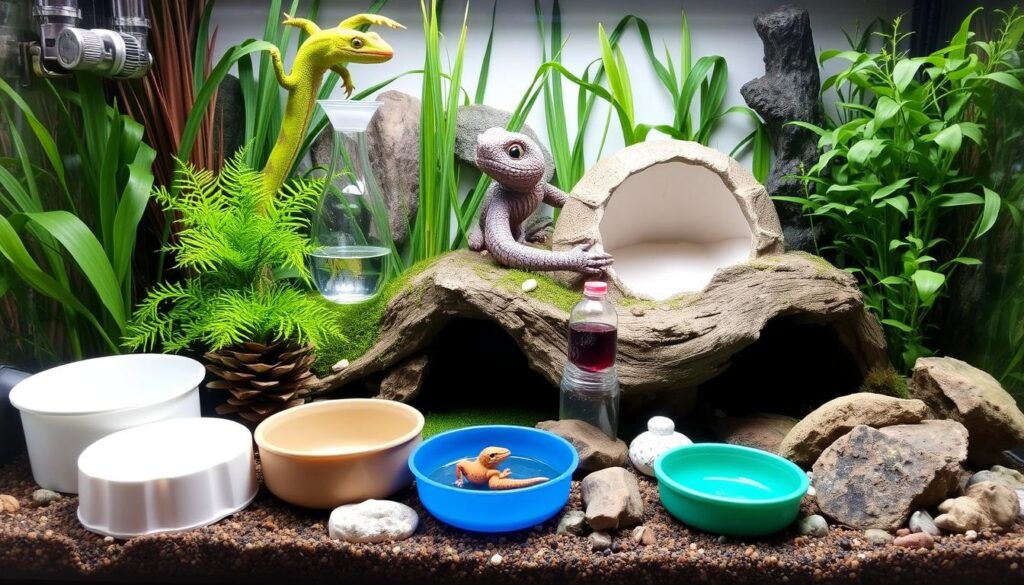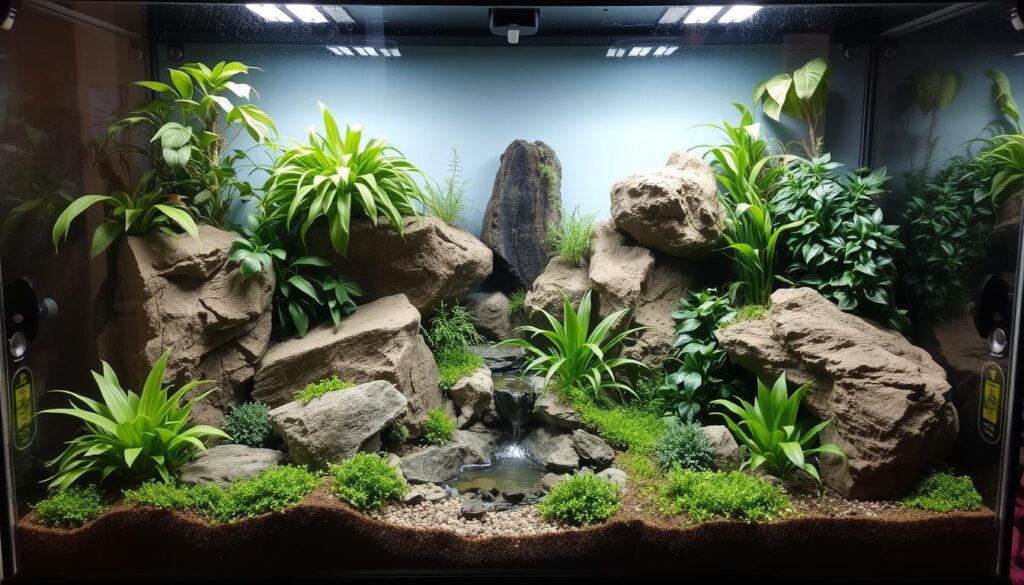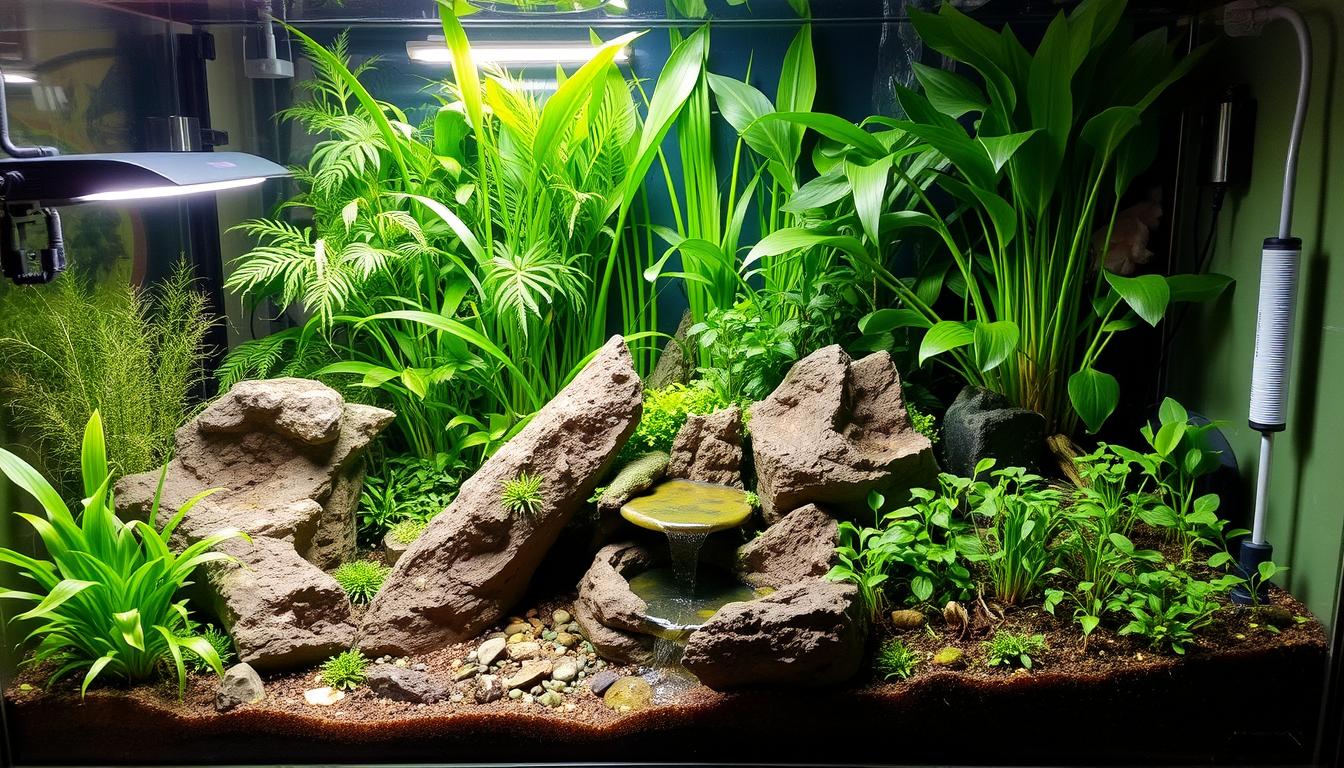Setting up a reptile terrarium is an exciting project. It needs careful planning and attention to detail. It’s important to think about what your reptile needs. A good terrarium can make your reptile happy and healthy.
This guide is for both new and experienced reptile owners. It will help you set up a terrarium, from choosing the right enclosure to keeping it healthy. By following this guide, you can make a great home for your reptile.
Key Takeaways
- Setting up a reptile terrarium requires careful planning and attention to detail
- A well-designed terrarium can provide a healthy and thriving environment for your reptile
- Choosing the right enclosure is crucial for a successful reptile habitat setup
- Understanding the specific needs of your reptile is essential for creating an optimal environment
- Regular maintenance is necessary to keep your reptile terrarium clean and healthy
- Setting up a reptile terrarium can be a fun and rewarding experience with the right guidance
Understanding the Basics of Reptile Terrariums
Creating a reptile enclosure requires careful thought. You need to know about the different terrariums available. These include glass, plastic, and wooden enclosures, each with its own advantages and disadvantages.
Glass terrariums are great for reptiles that need a lot of humidity. On the other hand, plastic terrariums are better for reptiles that prefer a drier environment.
It’s important to learn how to create a reptile enclosure that fits your pet’s needs. You should consider the size of the terrarium. It should be at least 2-3 times the length of your reptile to ensure enough space for movement and natural behaviors.
Different Types of Terrariums
Here are some popular terrarium types:
- Glass terrariums: ideal for reptiles that require high humidity
- Plastic terrariums: better suited for species that need a drier environment
- Wooden terrariums: a good option for reptiles that require a more natural environment
Size Requirements for Various Species
The terrarium size depends on the reptile species. For example, a ball python needs a smaller terrarium than a green iguana. It’s crucial to research the specific size needs for your reptile to provide the best environment.
Essential Components Overview
When creating a reptile enclosure, consider several key components. These include heating, lighting, substrate, and decor. Each plays a vital role in creating a healthy environment for your reptile. Understanding these essentials helps you create a suitable enclosure for your pet.
For more information on reptile care, visit petsrelax.com to learn about other animals and their fascinating histories.
| Terrarium Type | Pros | Cons |
|---|---|---|
| Glass Terrariums | Ideal for high humidity, easy to clean | Can be heavy, expensive |
| Plastic Terrariums | Lightweight, affordable | May not be suitable for high humidity, can be prone to scratches |
| Wooden Terrariums | Natural look, can be customized | May require more maintenance, can be expensive |
Choosing the Right Terrarium Size and Material
When picking a terrarium for your reptile, size and material matter a lot. The terrarium size should match the species, age, and number of reptiles. A good rule is to give 2-3 square feet of space for each adult reptile.
For example, a 20-gallon terrarium is great for one adult bearded dragon. But, a 40-gallon terrarium is better for two adult dragons.
When it comes to material, glass, acrylic, and wooden vivariums are popular. Each has its own advantages and disadvantages. Glass terrariums are tough and easy to clean but can be heavy and pricey. Acrylic terrariums are light and cheap but might scratch easily. Wooden vivariums look nice and can be customized but need more care.
Think about the reptile tank decoration and the look you want when picking a terrarium material.
Here are some key things to think about when picking a terrarium:
- Size: Make sure it’s big enough for your reptile to move and exercise.
- Material: Pick something durable and easy to clean that fits your budget and style.
- Ventilation: Make sure it has good air flow for your reptile’s health.
- Placement: Think about where you’ll put the terrarium in your home. It might affect your size and material choice.
By thinking about these points and picking the right terrarium size and material, you can make a comfy and healthy home for your reptile. Add some reptile tank decoration to make their space even better.
| Terrarium Material | Pros | Cons |
|---|---|---|
| Glass | Durable, easy to clean | Heavy, expensive |
| Acrylic | Lightweight, affordable | May scratch easily |
| Wooden | Aesthetically pleasing, customizable | May require more maintenance |
Creating the Perfect Environment: Temperature and Humidity
To make a great home for your reptile, knowing about temperature and humidity is key. Terrarium heating and lighting are vital for a natural feel. A temperature range is needed for your reptile to stay comfortable. Use a heat lamp or ceramic heat emitter and a thermometer to keep it right.
For more tips on setting up a reptile tank, check out this guide on reptile care. To control humidity, you can use misting systems, foggers, or special substrates. It’s all about finding the right balance for your reptile.
- Misting systems: These systems release a fine mist of water into the air, increasing the humidity levels.
- Foggers: Foggers use a combination of water and heat to create a fog-like atmosphere, perfect for reptiles that thrive in humid environments.
- Substrate choices: Certain substrates, such as sphagnum moss or coconut fiber, can help maintain humidity levels by retaining moisture.
Understanding temperature and humidity is crucial for your reptile’s happiness. Use thermometers and hygrometers to get it just right. Always research what your reptile needs to ensure you’re giving them the best care.
| Reptile Species | Temperature Range | Humidity Level |
|---|---|---|
| Bearded Dragons | 75-90°F | 30-50% |
| Leopard Geckos | 70-85°F | 20-40% |
Setting Up a Reptile Terrarium: Step-by-Step Process
When setting up a reptile terrarium, it’s key to follow a step-by-step guide. This ensures a healthy home for your pet. Begin by cleaning and disinfecting the terrarium. Then, add background materials like rocks, plants, or a water feature.
Next, set up the heating and lighting systems. Make sure to provide a temperature gradient and UVB lighting. This meets your reptile’s specific needs.
A crucial part of setting up a reptile terrarium is choosing the right substrate. Options include sand, gravel, or reptile carpet. Arrange decor like rocks, plants, and hiding places to make the environment natural and stimulating.
Consider these steps to create a perfect habitat:
- Clean and disinfect the terrarium
- Install background materials
- Set up heating and lighting systems
- Add substrate and arrange decor
Remember to research your reptile’s specific needs. This includes temperature, humidity, and lighting requirements. By following these steps and doing your research, you can create a thriving and healthy environment for your pet.
Setting up a reptile terrarium requires patience, attention to detail, and a commitment to providing a healthy and stimulating environment for your pet. With the right materials and a little planning, you can create a beautiful and thriving ecosystem that will bring joy and wonder to your life.
Selecting and Installing Proper Lighting Systems
Creating a great home for reptiles means focusing on terrarium heating and lighting. Many reptiles need UVB lighting to make vitamin D3. This vitamin is key for calcium and bone health. The right UVB light depends on the reptile and the terrarium size.
Choosing the right UVB bulbs and heat lamps is crucial. Think about the terrarium size, the reptile’s UVB needs, and the need for heat lamps. Heat lamps help create warm spots. UVB bulbs give the ultraviolet light needed for vitamin D3.
A good lighting system also needs day/night cycles. This can be done with timers or automated systems. Here are some important things to think about when picking and setting up lighting:
- UVB requirements: Find out what UVB your reptile needs and pick the right bulbs.
- Heat lamps and fixtures: Choose heat lamps that fit your terrarium and reptile’s needs.
- Day/night cycling: Use timers or automated systems to create a natural day/night cycle. This helps your reptile’s natural behaviors and health.
By picking and setting up the right lighting, you can make a healthy home for your reptile. Always do your research to meet your reptile’s specific needs. This way, you can give them the best care possible.
| Lighting Component | Description |
|---|---|
| UVB Bulbs | Provide ultraviolet light for vitamin D3 synthesis |
| Heat Lamps | Create basking spots and maintain temperature gradients |
| Timers/Automated Systems | Regulate day/night cycling to mimic natural conditions |
Choosing and Laying the Right Substrate
Choosing the best terrarium substrate is key for your reptile’s comfort and health. The right one keeps humidity levels right, prevents health problems, and encourages natural burrowing. Popular substrates include coconut fiber, reptile carpet, sand, and bioactive substrates, each with its own benefits and drawbacks.
Coconut fiber is a favorite for its moisture retention and mold prevention. Reptile carpet is easy to clean and helps avoid respiratory issues. Sand and bioactive substrates need more care but can be good choices if done right.
Consider these when picking a substrate:
- Humidity retention: Some substrates hold moisture better, great for reptiles needing high humidity.
- Ease of cleaning: Some are easier to clean, perfect for those with busy schedules.
- Natural burrowing behaviors: The right substrate encourages reptiles to burrow naturally.
The best terrarium substrate for your reptile depends on its needs and likes. By picking a quality substrate and following care tips, you can make a great home for your reptile.

Adding Essential Furniture and Decorations
Creating a good environment for your reptile is key. Reptile tank decoration is very important. It helps your pet feel safe, control its temperature, and see interesting things. Start by adding hiding spots like rocks, plants, or special hiding places.
Climbing structures are also vital for many reptiles. You can use branches, rocks, or fake vines. Pick them based on what your pet can do. Some reptiles are great climbers, while others are not.
Hiding Spots and Shelters
- Rocks and stones
- Plants and greenery
- Commercial hiding places, such as caves or tunnels
Climbing Structures
- Branches and sticks
- Rocks and boulders
- Artificial vines and climbing walls
Choosing terrarium accessories like water features is important. Some reptiles, like turtles, need water to swim and drink. Others, like snakes, just need a shallow dish for water.
Water Features
| Type of Water Feature | Benefits |
|---|---|
| Pools and swimming areas | Provide exercise and recreation for reptiles that require water |
| Waterfalls and misting systems | Help maintain humidity and provide a natural, stimulating environment |
| Shallow dishes and water bowls | Provide a source of drinking water for reptiles that do not require swimming areas |
By picking the right reptile tank decoration and terrarium accessories, you can make a great environment. It will be fun for your reptile and interesting for people to watch.
Ventilation and Air Circulation Systems
Learning how to create a reptile enclosure means focusing on ventilation and air circulation. Good airflow keeps the environment healthy, stops air from getting stuck, and lowers the chance of breathing problems in reptiles. A well-ventilated space means the air moves, taking away waste and extra moisture.
Air circulation can be set up in many ways, like screen tops, vents, and small fans. These tools make a soft breeze that moves the air and stops it from getting still. Adding these features helps reptiles stay healthy and do well in their homes.
To make air circulation work well without messing up temperature and humidity, try these tips:
- Use a screen top to let air in while keeping temperature and humidity right
- Put in vents for more air flow and to stop air from getting stuck
- Use small fans to move the air and make a soft breeze
By using these tips and learning about reptile enclosure ventilation, owners can keep their pets healthy and happy. It’s important to know what your reptile needs for the best environment.
| Ventilation Method | Benefits |
|---|---|
| Screen Top | Allows for airflow while maintaining temperature and humidity levels |
| Vents | Provides additional airflow and prevents stagnation |
| Small Fans | Circulates the air and creates a gentle breeze |
Installing Feeding and Water Stations
Setting up a reptile terrarium means installing feeding and water stations. This is where terrarium accessories play a key role. They help create a safe and healthy space for your reptile to live.
It’s important to place food dishes in the right spot. You should think about how easy it is to get to, how clean it stays, and how it fits with your reptile’s natural eating habits.
There are many types of food dishes for different reptiles. Some need shallow dishes, while others prefer deeper ones. Pick a dish that fits your reptile’s needs to make mealtime better. Also, terrarium accessories like water bowls and feeding tongs help keep things clean and safe.
Food Dish Placement Considerations
- Accessibility: Place food dishes in an easily accessible location, allowing your reptile to feed comfortably.
- Cleanliness: Choose a dish that is easy to clean and maintain, reducing the risk of bacterial growth.
- Natural feeding behaviors: Observe your reptile’s natural feeding behaviors and place the food dish accordingly.

By setting up feeding and water stations that meet your reptile’s needs, you can make a great environment. Choose terrarium accessories that are safe and comfortable for your reptile. This will help keep your pet happy and healthy.
Safety Features and Escape Prevention
Keeping reptiles safe is a big deal. A safe place is key for both the reptile and its owner. To stop escape and keep things safe, you need to add special features to the terrarium. This includes strong lids, locks, and sealing any gaps. Also, picking the right materials for the terrarium is important, as some can hurt the reptile.
Some important things to think about for safety and preventing escape include:
- Secure lids and locks to prevent the reptile from escaping
- Proper sealing of any openings to prevent the reptile from squeezing through
- Choosing materials that are safe for the reptile, such as non-toxic substrates and decorations
- Placing heating elements and lighting fixtures in a way that prevents burns or other injuries
Adding these safety features to the reptile habitat setup makes a safe and healthy space for pets. It’s also key to think about how different reptiles move, like climbing or burrowing, when setting up the terrarium. With the right safety measures, owners can enjoy their reptilian pets safely and without worry.
Creating a safe and secure reptile habitat is crucial for both the reptile and its owner. By following these tips and thinking about your pet’s needs, you can make a happy and healthy home for your reptilian friend.
Maintaining Proper Hygiene and Cleaning Routines
Keeping a reptile terrarium clean is key for their health. Daily tasks like spot cleaning and water changes stop bacteria and waste buildup. A weekly routine should include cleaning the substrate, decorations, and disinfecting food and water dishes.
For more info on bioactive vivarium maintenance, learn about your reptile’s needs. This includes ventilation, temperature, and humidity control.
Deep cleaning is needed often to keep the terrarium clean. This means safely removing the reptile, cleaning everything, and putting it back together. Regular reptile terrarium maintenance keeps your reptile’s home healthy and safe.
Some important weekly tasks are:
- Substrate maintenance
- Decor cleaning
- Disinfection of food and water dishes
By following these tips and keeping up with reptile terrarium maintenance, you can make a great home for your reptile.
Troubleshooting Common Setup Issues
Setting up a reptile habitat can sometimes go wrong. This can harm your pet’s health. Issues like wrong temperatures, humidity problems, and lighting issues are common. Knowing what causes these problems and how to fix them is key.
Signs of a bad setup include your reptile acting tired or not eating. They might also show stress signs like skin problems or breathing issues. Here’s what you can do:
- Make sure the temperature is right for your reptile
- Check the humidity is good for your reptile
- Make sure the lights are working right and giving enough UVB
By fixing these issues early, you can keep your reptile healthy. Always do your research and talk to a vet or experienced breeder if you’re not sure.

Keeping an eye on your reptile’s habitat is important. Regular checks and maintenance can prevent problems. This way, your pet can thrive and grow well.
| Common Issue | Potential Cause | Corrective Action |
|---|---|---|
| Temperature fluctuations | Malfunctioning heating or cooling system | Replace or repair the faulty component |
| Humidity imbalances | Inadequate ventilation or water supply | Increase ventilation or adjust water levels |
| Lighting malfunctions | Failed or outdated lighting components | Replace with new, suitable lighting |
Conclusion
Setting up a reptile terrarium is a journey that needs dedication. You must understand your reptile’s needs, get the right equipment, and keep a clean and caring environment. This way, your pet can live happily and healthily.
A good reptile terrarium shows your love and care for your pet. Keep an eye on the temperature, humidity, and other factors. This ensures your reptile is happy and comfortable.
Be ready to make changes to your reptile terrarium setup as your pet grows. Being patient and persistent will help you create a great home for your reptile. With time and attention, your terrarium will become a vibrant and natural space for your pet to enjoy.

